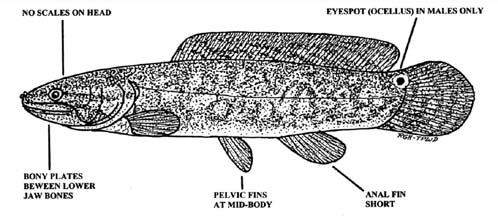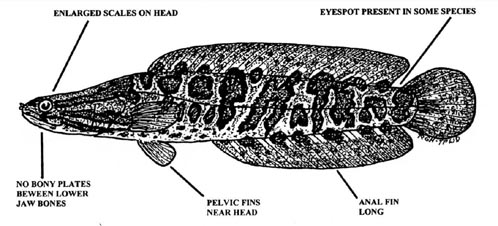Bowfin vs. Snakeheads: Distinguishing Features
Snakeheads, native to Africa and Asia, are occasionally imported illegally into the United States and into Texas. All snakeheads (family Channidae) are prohibited species in Texas. They closely resemble native Bowfin (Family Amiidae), which are often mistaken for snakeheads, but Bowfin and snakeheads are unrelated. This page shows the identifying characteristics for Bowfin and one species of snakehead that has invaded other areas of the United States. There are more than 25 species of snakeheads, some of which may lack pelvic fins. Snakeheads have not been found in the wild in Texas, but could cause harm to our sport fisheries as well as threatened and endangered species if they were introduced. If you see or catch a fish that you think may be a snakehead, don't release it alive! Take photos, compare the fish to the illustrations below, and send your photos and a report of where the fish was found to Texas Parks and Wildlife Department at aquatic.invasives@tpwd.texas.gov.
 [D]
[D]Bowfin (Amia calva)
Native species, not prohibited in Texas
 [D]
[D]Northern Snakehead (Channa argus)
Exotic species; prohibited in Texas
Figures and text prepared by R.G. Howells, Heart of the Hills Research Station, Ingram, Texas
Bowfin (Amia calva)
- No scales on head
- Bony plates between lower jaw bones
- Pelvic fins at mid-body
- Anal fin short
- Eyespot (Ocellus) at base of tail, in male specimens only
Snakehead (Channa argus)
- Enlarged scales on head
- No bony plates between lower jaw bones
- Pelvic fins closer to head
- Anal fin long, almost as long as dorsal fin
- Eyespot present in some species